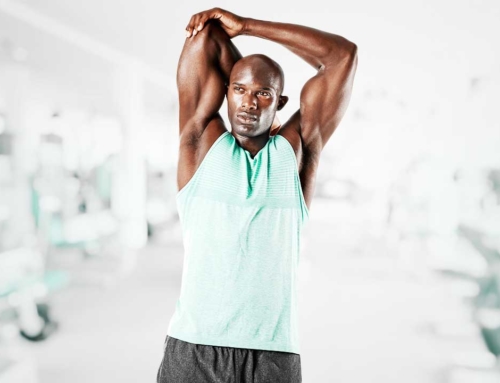To many The Paleo Diet might sound like a fad or another marketing ploy in the fitness industry, but The Paleo Diet isn’t really a “diet,” and it’s just another way of eating that could fit your lifestyle. It’s important to note that there is no single diet out there that is the best for everyone. Every one of us is an individual and we should be treated that way when it comes to eating. Just because your best friend is doing The Paleo Diet, doesn’t mean you have to.
How did it start?
The Paleo Diet is solely based on our ancient ancestors thrived as hunter-gatherers thousands of years ago. Although it’s been a really long time, our genetics haven’t changed that much since then. And yet…
The average Homo Sapien back then: muscular, agile, athletic, and incredibly versatile.
The average Homo Sapien now: overweight, out of shape, stressed out, unhappy, sleep deprived and dying from far too many preventable diseases due to lifestyle choices.
A few thousand years ago, humans discovered farming, the agricultural revolution took off, and we advanced from hunter-gatherers to farmers. We settled down, formed societies, and the human race progressed to what we are today.
The paleo community believes the problem is, our bodies never adjusted properly to eating all the grains and sugar that we are now consuming.
As paleo guru Robb Wolf puts it, think of a 100-yard football field. The first 99.5 yards are how long Homo-Sapiens spent as hunter-gatherers. As they became good at hunting and gathering our bodies adapted to that lifestyle over thousands of years. That last half-yard represents our species after the agricultural revolution, where our diet has shifted but our genetics haven’t.
So, instead of loading up on meat, vegetables, and seasonal fruits, we’ve become a species “dependent” upon grains such as bread, pasta, rice, corn, and so on.
With an explanation like this, it’s difficult to disagree with a Paleo enthusiast and especially when we live in a world where 66% of us are overweight, 33% are considered obese, and those numbers are only getting worse.
Clearly, something’s not right, and we need to fix it.
The Paleo Diet is an effort to go back to eating how we’re biologically designed to eat, allowing us to tap into our genetic potential and start living healthier immediately.
Back in the day, grains weren’t part of our diet.
When we over-consume grains regularly, our bodies take those grains, which are composed of carbohydrates, and those carbs get turned into sugar in our system. That sugar is then either burned as energy or stored as fat.
Most grains contain gluten and lectins.
You’ve probably heard of these terms before, but here is a little summary:
Gluten is a protein found in things like rye, wheat, and barley.
It’s now being said that much of our population may be gluten-intolerant. Over time, those who are gluten intolerant can develop a dismal array of medical conditions from consuming gluten: dermatitis, joint pain, reproductive problems, acid reflux, and more.
Lectins are natural toxins that exist in grains to defend against consumption!
Yup. Grains have evolved to keep themselves from being eaten by us. These lectins are not a fan of our gastrointestinal tract, and they prevent the tract from repairing itself from normal wear and tear. This can cause all kinds of damage.
In short: our bodies don’t process grains that well, and they can cause some problems.
The Paleo Diet also almost completely eradicates sugar. Unless you’re getting your sugar from a fruit, forget it. Sugar causes an energy spike and crash in your system, turns to fat unless it’s used immediately, and wreaks all kind of havoc on our bodies. In summary, the Paleo Diet promotes, no grains, no sugar, no processed foods. Whether you’re talking about the paleo diet or not, many studies have shown that an incredible number of diseases and lifestyle issues can be reversed with these three simple changes.
No carbs?
Where are we supposed to get our energy from? Our bodies are designed to operate on a lower number of carbohydrates than what we’re used to eating, so fewer carbs isn’t an issue once you re-train your body to process the food you’re eating.
When there is an absence of carbs, our body will take stored fat and burn THAT for energy in a process called ketogenesis which is another diet craze right now called The Ketogenic Diet.
But, carbs still serve a purpose in our diets, but they’re not essential. Many Paleo followers prefer to get carbs from vegetables, sweet potatoes, and fruit. Why is that? These foods are naturally occurring in the wild and don’t need to be processed in any way in order to be consumed. The other great thing about vegetables is that they’re incredibly nutrient dense and calorie light.
Six full servings of broccoli has 180 calories and 36 grams of carbs. A single serving of pasta and keep in mind almost no one eats a single serving of pasta
has 200 calories and 42 grams of carbs.
Now, eating paleo does not automatically mean that you are doing a ketogenic diet (no carb) or a low-carb diet. However, even if you have a serving of sweet potato (26g per 1 cup serving) with every meal, it’s likely a lot lower in carbs than you’re used to having.
Paleo followers do recommend keeping your carb content low – loading up on buckets of fruit is technically Paleo but can result in a ton of carbs and sugar consumed.
Knowing what to eat is part of it but following this restrictive lifestyle in a modern environment surrounded by cookies and candy and bagels and pasta is really difficult! Factor in the “carb withdrawal” you might go through in the first few weeks as your body gets weaned off of carbohydrate fuel and habits, and most people give up on the Paleo diet long before it creates lasting change!
What About Dairy?
Dairy’s a tough one, as most Paleo folks tend to stay away from it.
A portion of the world is lactose intolerant, and those that don’t usually have at least some type of an aversion to it. Why is that? Because no other animal in the entire kingdom drinks milk beyond infancy. Hunter-gatherers didn’t lug cows around with them while traveling – milk was consumed as a baby, and that was it. As with grains, our bodies weren’t designed for massive dairy consumption.
There is evidence that some adaptation to dairy has taken place throughout the years, specifically with people with ancestry in herding cultures, but this is not the majority of the population. But this is a heavily debated topic and is best to stay away from.
So, this is one that Paleo purists will avoid like the plague, while others have found that consuming dairy in its various forms work for their genetics, goals, and lifestyle. If you’re not sure, remove dairy from your diet and only introduce it back in when you’re ready to see how your body responds.
If you’re confused what you can and cannot eat, here is a simple list:
· Meat – GRASS-FED*, not grain-fed. Grain causes the same problem in animals as they do in humans.
· Fowl – Chicken, duck, hen, turkey…things with wings that (try to) fly.
· Fish – Wild fish, as mercury and other toxins can be an issue in farmed fish
· Eggs – Look for omega-3 enriched cage free eggs.
· Vegetables – As long as they’re not deep-fried, eat as many as you want.
· Oils – Olive oil, coconut oil, avocado oil – think natural.
· Fruits – Have natural sugar, and can be higher in calories, so limit if you’re trying to lose weight.
· Nuts – High in calories, so they’re good for a snack, but don’t eat bags and bags of them.
· Tubers – Sweet potatoes and yams. Higher in calories and carbs, so these are good for right after a workout to replenish your glycogen levels.
*If you can only afford grain-fed meat, that’s still better than grains. Do the best you can with your situation!
Steak with asparagus and sweet potato fries, grilled chicken salad, massive omelets that will fill you up for the whole morning, apples dipped in almond butter also works really well. Pick any of the things from that list, and eat as much as you want of them without going overboard and you’ll be on the right track of eating Paleo.
Because these foods are so nutritious and filling, you’ll be eating satiating foods that fill you up but are not carb-calorie dense.
Now, is the Paleo diet right for you? Maybe!
The important thing to remember is to ask yourself one question when faced with a decision if you want to follow a new diet.
“Can I do this diet for the rest of my life?”
If the answer is no, then it’s probably not the best choice. You need to find something that works for you and your lifestyle and finding a balance between eating like a bodybuilder and enjoying comfort foods with friends and family.
Nutrition is individual to everyone, don’t force yourself into something just because social media tells you to, or your friends. Be smart!









Leave A Comment